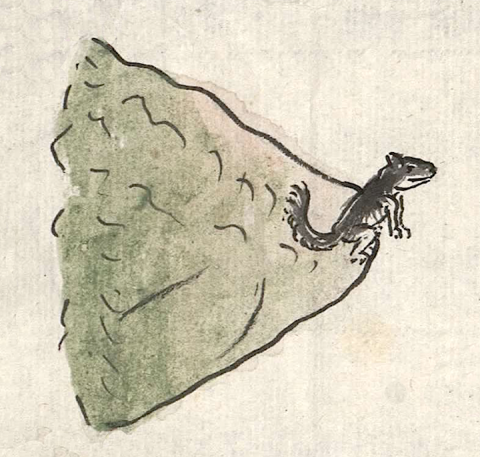Epazoyocan (CmpRG)
This is a compound glyph naming the community called Epazoyocan. It is featured in the 1580 Relación Geográfica de Cempoala (originally Cempohuallan, and now Zempoala, Hidalgo). It consists of a hill (tepetl) with a skunk (epatl) perched on the summit. The hill is more like a European-style landscape item than a tepetl glyph. The skunk is a phonetic element providing the epa- part of the name. The hill, which plays the role of a semantic indicator of place, is shown naturalistically and is cone-shaped something like a volcano. It is outlined in black, with a tan-colored summit area shifting to green down its slopes. Black lines in its interior suggest a rocky or uneven surface. The skunk is rendered in black with a white underbelly. It appears to be rising up on its hind legs. The compound glyph is shown here on its side, facing right, because the gloss and rendering of Epazoyocan’s Augustinian church—a semantic indicator for an inhabited place on this map—is in that direction. The -yocan ending of the place name, not depicted visually, consists of -yotl, “having the nature of,” and the locative -can, “place of.” Alternately, there is a word that specifically means “redolent of mint/herbs” (epazoyo), which would suggest a translation of the place name as “place redolent of herbs.”
Robert Haskett
Epazoyocan, though appearing on the Cempohuallan map, was actually an independent cabecera (head town) with its own set of subject communities. It has a Relación Geográfica and map (see the museum and rare book comparison, below). The Cempohuallan jurisdiction was interspersed with that of Epazoyocan, hence its inclusion on the present map (see the historical contextualizing image). Beyond this, there are at least two things that demand further explanation. The first is the use of the image of a skunk rather than a rendering of the epazotl herb, or as in another manuscript an image of a skunk with the herb on its back (see below), in the present compound glyph. Omitting this herbal element seems to have put additional weight on the alphabetic gloss and image of the church to fill out its full meaning. Still, one would have had to be in the know to fill in the blanks left by this compound glyph. The second thing is that, somewhat confusingly, the hill at first seems to be associated with a different place name and church found at its base, Tetzahuapa, (see the historical contextualizing image). Thus, it is possible that the hill serves as a more traditional, if heavily Europeanized, semantic indicator of “place” for both Epazoyocan and Tetzahuapan. For more information about the RG map, see Biblioteca Digital Mexicana, A.C., http://bdmx.mx/documento/mapas-relaciones-geograficas-cempoala-epazoyuca... Mundy, Barbara E., “Mapping Babel: A Sixteenth-Century Indigenous Map from Mexico,” The Appendix, 1:4 (October 2013), Mundy (1996), and Ballesteros García (2005), 71, figure 43.
Robert Haskett
Epaçoyoca
Epazoyocan
Robert Haskett
1580
Robert Haskett
mints, hierbabuena, herbs, las hierbas, skunks, los zorrillos, nombres de lugares
The Spanish-language text of the Relación Geográfica de Epozoyocan defines this place name as “donde ay muchos Epaçotes que es yerua calida como yerua buena….” (where there are many epazotes, which is a hot herb like mint) [folio 13 verso]. This map does have some “Indigenous” elements in it, such as in the depiction of a very rocky range of hills rising above the grid of the community itself, which according to the Spanish text was called “Tlaloc.” While fairly “European” in its depiction of this natural feature has some older elements in it, such as a few that appear to be somewhat like the traditional curled ends of a tetl glyph, a large water feature rendered in a style very much like depictions of such things in older manuscripts, as well as nopal cacti and maguey plants. The rendering of the town itself is a mixture of the old and the new, as well, with a grid-like pattern of streets, a few with a combination of human footprints and hoof marks rendered on them (a style that seems to have appeared in the later sixteenth-century as horses and mules became more common in and around Indigenous communities). Renditions of houses seem similar to older ways of depicting calli. And the maize fields depicted at the bottom of the map have maize stalks with visible root balls, another older convention. Epazoyocan’s Augustinian church and its atrium, however, are more thoroughly European in their presentation and much grander than they are pictured on the Cempohuallan map, which is not surprising, of course. The Relación Geográfica de Epozoyocan can be accessed digitally through the University of Texas Libraries, https://collections.lib.utexas.edu/catalog/utblac:c5f60019-ec83-41b3-864....

epa(tl), skunk, https://nahuatl.wired-humanities.org/content/epatl
epazotl, mint or fresh herb, https://nahuatl.wired-humanities.org/content/epazotl
epazoyo, something redolent of mint, epazotl, https://nahuatl.wired-humanities.org/content/epazoyo
-yocan, place where there is a lot of (the preceding noun), https://nahuatl.wired-humanities.org/content/yocan
-yotl, having the nature of, https://nahuatl.wired-humanities.org/content/yotl
-can, place of, https://nahuatl.wired-humanities.org/content/can-2
lugar de las hierbas
Robert Haskett
Relación de Cempoala - University of Texas Libraries Collections. 1580-11-01. https://collections.lib.utexas.edu/catalog/utblac:f87917e2-e3c9-4eb2-a83...
Materials that are in the public domain (such as most of the maps in the PCL Map Collection) are not copyrighted, and no permission is needed to copy them. You may download them and use them as you wish. The image appears here courtesy of the University of Texas Libraries, The University of Texas at Austin. If you do publish anything from this database, please cite the Visual Lexicon of Aztec Hieroglyphs.





